Hypha Studios was founded by Camilla Cole and Will Jennings to bring culture and engagement with the arts to the public throughout the UK and help artists unlock new bounds of personal practice by unlocking vacant property units, free of charge.
Already extremely successful, Hypha desperately want to expand their good work, searching for new spaces for an ever-growing list of artists and creatives. In return, they offer tailor-made creative solutions for any size and tenure of vacant property.
In his conversation with Founder and CEO Camilla Cole, Futurecity Senior Strategist George Kekatos explores the work of the charity and its hopes for the future.
– Mark Davy, Hypha Trustee
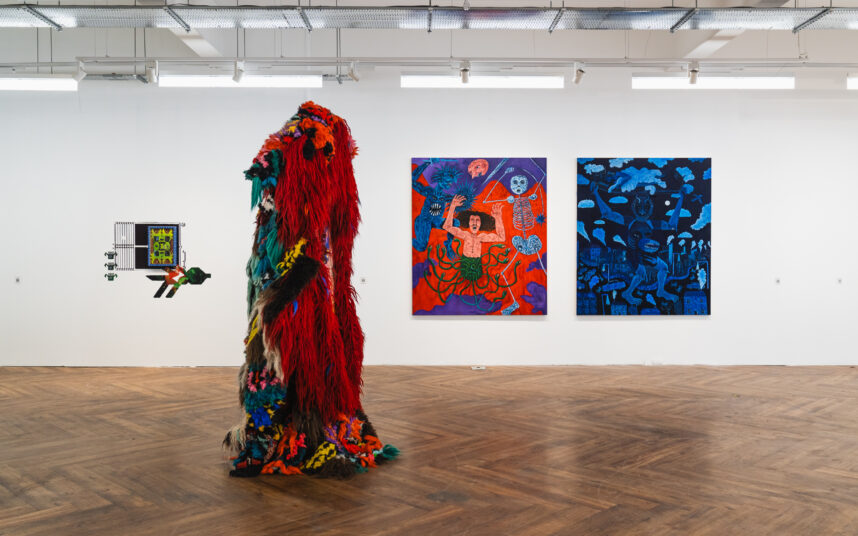
George Kekatos: Tell me a bit about you and your background. How did Hypha start?
Camilla Cole: My background is in contemporary art, which means I’m completely unemployable in any other sector or job! I started when I was 19 and I’ve worked behind high-net worth individuals and organisations to buy and sell artworks for them. That gave me a very good understanding of the contemporary art market.
One of my big goals with Hypha is to support good, emerging artists and trying to find the next best exciting talent.
To go back to my background, I used to buy and sell artworks for private art collections. But then, at around 25, you realise that the art world has a glass ceiling. As you progress and get a bit older, you realise it’s not easy to make more than £30k in the art world. I then decided to study on the Curating Course at Goldsmiths, realising that there were 30 people in the course and there must be about 30 curating jobs in the whole country. So, I realised, “okay I’m never going to make money out of this. I’m out”.
So, I took the funds intended for my second year and started doing pop-up exhibitions and realised that this was actually saving money for landlords in empty spaces. I worked out a business plan and then not much later, applied to become a charity. Then, I started understanding the world of charity and properties. Slowly came to the realisation that I’m not in this to make money out of contemporary art – artists are valuable by themselves. There was the idea that if we give artists free space in return for certain things that they’re able to do through their work, we might be able to collectively access properties. That’s how Hypha was born.
I now love working with property developers and properties.
The idea was to create a sort of diplomat, work out what artists wants, which is usually free space, network support and opportunities, being part of something. The landlords on the other hand, want activation, especially when it looks cool, have the right people that understand their ESG and community goals.
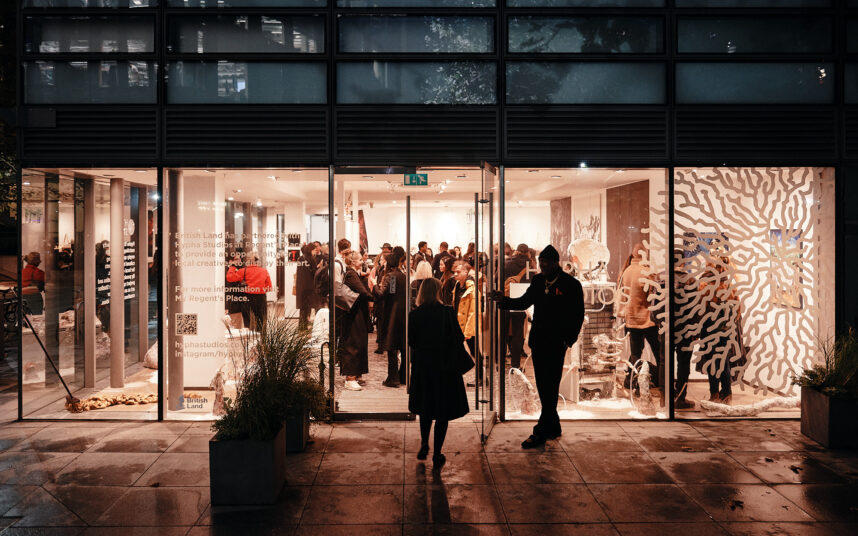
So, the deal is this, we sign a lease for a licence to use the space for studios and exhibitions and then in return for the free space the artists do free events for the community. And they do social media marketing, supported by the landlord, and they give us feedback about who’s attending. We find them through an open call process for each location and the output is specific to every site.
So that’s me in a nutshell. Basically, I set this up to remove the gatekeeping culture in the art world. The best artists are not rich and need to have support. The UK has an amazing world of emerging artists and right now we’re suffering.
GK: When did you set up Hypha?
CC: I set up Hypha during the pandemic. At the time I was doing my own curator projects in various unconventional locations like car parks, zoom calls and that was getting slightly tedious. Around that time, I found an empty shop in Eastbourne and did an open call. Having grown up in Eastbourne, I was very curious as to who would apply, knowing that there is only one art school there, ECAT (Eastbourne College of Arts and Technology). As it turns out, we got 40 artists in four days – and that was because artists from London were moving away as it was too expensive to be in London. We got responses from incredible artists with whom we’ve now gone back to work with in other places like Hastings. Those experiences made me realise that there could be traction.
The result from anywhere we go to work is an amazing and quite large dataset about creative and artistic need. We can tell you things about the art scene of Derby compared to Bristol, or Reading compared to Southport, Catford compared to Islington.
GK: How big is your team and what is your structure of working together?
CC: The name Hypha originates in the white tendrils of a mycelial network. We’re like mushrooms, we go and create life out of dead space. We embrace the idea of a decentralised network which right now is centralised. As Founder and CEO, I am the main point of contact for everything. For two years, I was basically doing this alone but as our events started doing increasingly well, we are in a position to be growing. Recently, we got an Artist Team Assistant and a Fundraising Manager. Even though we’re a small team, it’s not really just us.
We currently have 13 sites running (but have operated in 32), with anywhere from 1-60 artists in each location (depending on studio making space or exhibition space) and they tend to work with us when they’re in the space. It’s slightly similar to Oxfam. The artists are volunteering their services to fulfil our charitable purposes. So, at any given team we have a potential team of 300 or more that fluctuates.
GK: What do you think is the impact of Hypha’s work on artists?
CC: Hypha does two things – we put together studio / making space, and exhibition space. At the moment, we focus on contemporary art, but have had theatre, dance and film and can cover all the creative arts. We gather a growing set of data of the impact we’ve had on the artists. What studio holders are enabled to do off the back of our work is amazing. Firstly, they can sell work without Hypha taking any fees or a cut. Secondly, they don’t have to spend their money on a studio, so they start to think more creatively about what their work is. They don’t have to think commercially, so they are enabled to make more exciting work. Thirdly, the network opportunities are incredible. Normally, when artists work in a studio, they don’t know who they’re with and with Hypha, suddenly, they have an obligation to do some public events and that helps them start to mesh and co-create part of it.
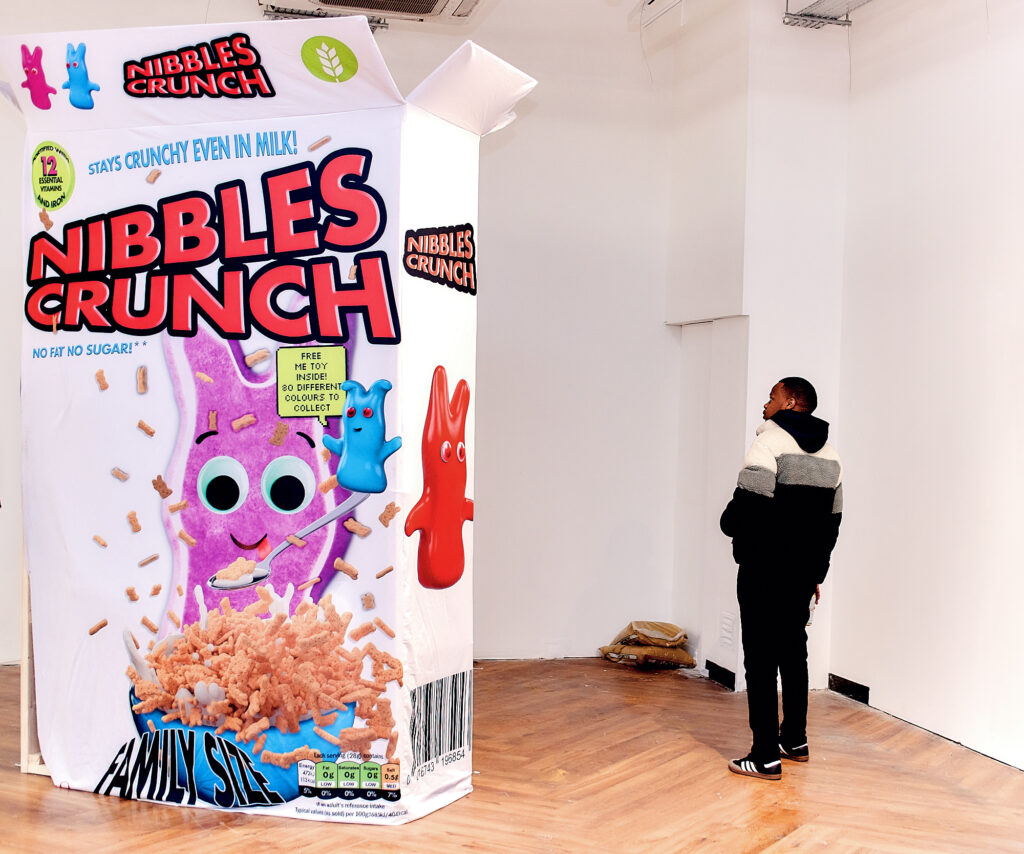
CC: More importantly, our social media helps with visibility, if you’re in a little unit in Battersea, Hastings, Southport, or Reading, you have 23,000 people that are art fans looking at your art, so you get pulled out of the abyss and being given a national platform. There’s also a lot of funding that goes along with having a free studio space (which is like it’s been awarded), therefore other people want to award you. Some of our artists do so well, that they don’t qualify for free studios anymore!
The benefits are clear –it’s visibility, career path opportunities, events, understanding how to do an exhibition (lots of artists don’t know how to and they can’t afford the space), so they don’t. They feel less scared to do it if they’ve got a free space, just to give it a go. They’re allowed to try any of those things. Hypha is about incubating innovation. Lots of them go on to do more shows together afterwards, we’ve had plenty of collectives come together, and plenty of free applications. If we get new sites in the future, big buildings, we will work again with those groups because they are very good, and we trust them. They will also look after the properties really well and that makes it easy to bring them back in. Hypha has a strong network, and it will keep going even if they go in spaces temporarily.
GK: How is Hypha’s work contributing to Placemaking in commercial developments?
CC: It is embedded in Hypha’s principles to not do anything that can even vaguely be considered art-washing. In terms of placemaking and the problems that word might entail; the idea is to not helicopter culture into the places we work in. Hypha is all about finding the culture that is already there and give people ownership over spaces. This is a really important part of our model; we cannot go to a place and pretend we know the best artists.
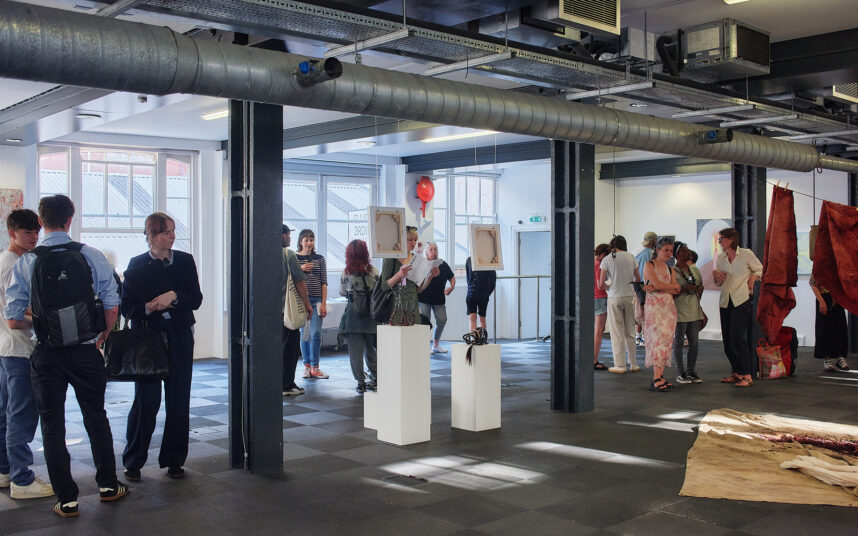
CC: It is crucial in our process, in every location we’re in, that artists reflect the culture on the high street. For example, in Catford, we had a unit with three incredible filmmakers who had never met each other. They were all five minutes away from the space and carried on working there. In Penrith, landscape painting is very popular, even though not so commercial – but that’s what reflected the culture that was there. That is one of the things that our model does particularly well is that we’re sort of a mirror – selected by local people for local people and featuring local people.
In terms of working with commercial landlords, when we first started, things were very challenging, I’ll be honest with you, and they weren’t very nice. Bearing in mind, I’m female, and I’m a curator. I had to get a man in the room to have property conversations for me, otherwise they wouldn’t listen to me.
Now things are changing, but we also work with the better landlords and developers, like British Land, the Crown Estate, Hammerson and Get Living. Those guys get the bigger picture. They don’t care about business rates, they care about development, they care about future they care about regeneration. Doing good means making money now. That’s the best thing about the time that we’re living in, right? If you have a community, people want to live there.

GK: Do you partner with cultural organisations and or institutional partners?
CC: When we first started, we had to give some level of authenticity about what we were doing to gain recognition, mostly for landlords, so we used to seek local partners. In many cases we include landlords, local councils, or any other key partners, in the selection of artists. If if there is a significant organisation that already exists in an area, we bring them on board to help us select who goes in. In this way they become part of the process and bring local knowledge. It’s not always possible, especially as we get, we get bigger and bigger, that’s quite a lot to orchestrate and organise.
This inclusion is a really good opportunity for local partners to see the grassroots culture on their doorstep. In Derby, 20-30% of the applicants we had were artists of colour – the people that ran the local museum partner, said to us they had no idea that their audiences were so diverse and that in turn would affect their programming and who they’re trying to bring in. If you don’t know that there’s an audience, you don’t facilitate it.
What we’re starting to do now, is in every unit we go in, we reach out to local groups and organisations. Euston, we have Facebook next door, but also got the local school, the local charity, and the local cultural organisation. So, we’re all teaming up and trying to work out the best programming. Next year, this might mean a sharing space and shared platforms. We also work with universities, we create ESG angles for landlords.
GK: What is your process of selecting artists through your open calls?
CC: This is a very vital point. We do a targeted Instagram adverts in certain areas. The idea is it’s a very short application form, as a curator, I know the pain of having to fill in a funding application. Very short form questions, and depending on the site, like, ‘what do you make?’, ‘Where do you live?’, ‘What is your background?’, ‘What are you going to do for the local community?’ etc. They can also declare if they are financial or physically struggling. It may ask about their ability to deliver and what do they need to do so. We then create a matrix and go through every single application, and we do a shortlist.
If we’re in a certain location, we might do it by slot. If it’s an exhibition, we’ll do slots, and we’ll programme according to what else is going on, like Halloween and Christmas and do some curating at that point. If it’s just studios, those are very much in demand, because there are 700 people, waiting lists everywhere for paid studios, let alone a free one. So, we get really exciting applications for the free studios.
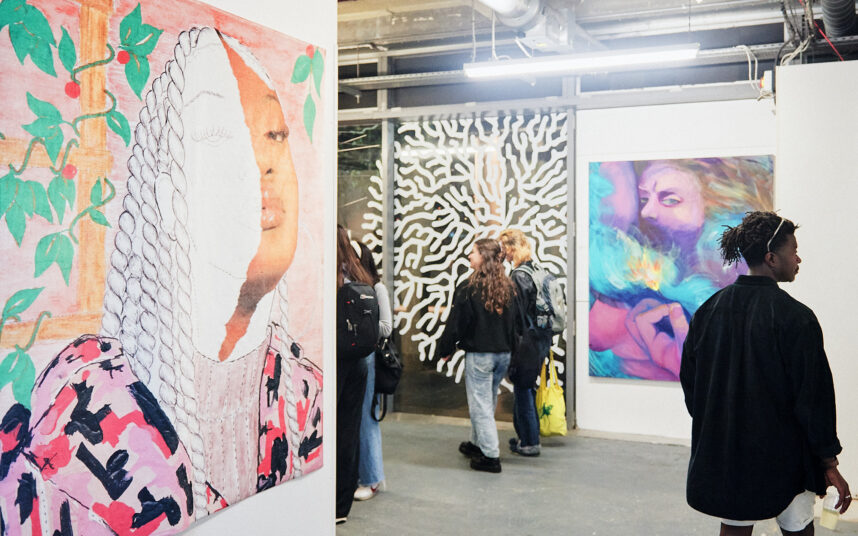
GK: What is your long-term vision for Hypha?
CC: In three years, I would like to see us operating everywhere in the UK, helping organisations that have lost their spaces due to cost of living crisis, COVID or redevelopment. That would mean landlords and property sector paying us to find the right organisations for their spaces.
In five years, it would be great to go international, starting with the US – then doing cultural exchanges and offering artists not just free space, but some financial support. Other ideas would be to have a consultancy section of Hypha. The opportunity to become an Art Uber / Airbnb model, where everything is automated and self-regulating. Landlords, artists, and cultural orgs sign up and they rate each other.
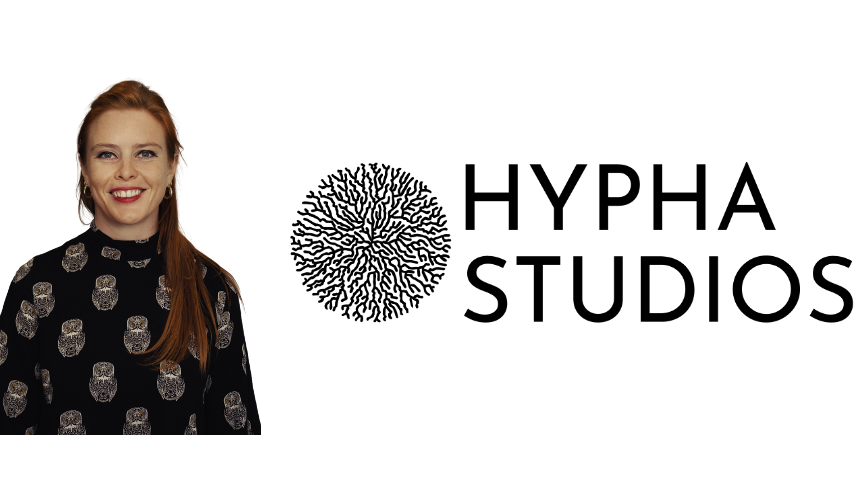
Camilla Cole, Founder & CEO of Hypha Studios Camilla has worked in the arts industry for nearly 20 years, managing private art collections and contemporary art galleries in London. She went on to become an experienced independent contemporary art curator dedicated to championing leading emerging artistic talent in the UK and internationally.
For more information on Hypha Studios, or upcoming events, please visit their website.
To get in touch with Hypha:
Studio Applications: [email protected]
Landlords: [email protected]

All photography by Carlo Zambon, images courtesy of Hypha Studios

Vacant Units to Cultural Spaces - An Interview with Hypha Studios Founder & CEO Camilla Cole
19/1/2024
Hypha Studios was founded by Camilla Cole and Will Jennings to bring culture and engagement with the arts to the public throughout the UK and help artists unlock new bounds of personal practice by unlocking vacant property units, free of charge.
Already extremely successful, Hypha desperately want to expand their good work, searching for new spaces for an ever-growing list of artists and creatives. In return, they offer tailor-made creative solutions for any size and tenure of vacant property.
In his conversation with Founder and CEO Camilla Cole, Futurecity Senior Strategist George Kekatos explores the work of the charity and its hopes for the future.
– Mark Davy, Hypha Trustee
George Kekatos: Tell me a bit about you and your background. How did Hypha start?
Camilla Cole: My background is in contemporary art, which means I’m completely unemployable in any other sector or job! I started when I was 19 and I’ve worked behind high-net worth individuals and organisations to buy and sell artworks for them. That gave me a very good understanding of the contemporary art market.
One of my big goals with Hypha is to support good, emerging artists and trying to find the next best exciting talent.
To go back to my background, I used to buy and sell artworks for private art collections. But then, at around 25, you realise that the art world has a glass ceiling. As you progress and get a bit older, you realise it’s not easy to make more than £30k in the art world. I then decided to study on the Curating Course at Goldsmiths, realising that there were 30 people in the course and there must be about 30 curating jobs in the whole country. So, I realised, “okay I’m never going to make money out of this. I’m out”.
So, I took the funds intended for my second year and started doing pop-up exhibitions and realised that this was actually saving money for landlords in empty spaces. I worked out a business plan and then not much later, applied to become a charity. Then, I started understanding the world of charity and properties. Slowly came to the realisation that I’m not in this to make money out of contemporary art – artists are valuable by themselves. There was the idea that if we give artists free space in return for certain things that they’re able to do through their work, we might be able to collectively access properties. That’s how Hypha was born.
I now love working with property developers and properties.
The idea was to create a sort of diplomat, work out what artists wants, which is usually free space, network support and opportunities, being part of something. The landlords on the other hand, want activation, especially when it looks cool, have the right people that understand their ESG and community goals.
So, the deal is this, we sign a lease for a licence to use the space for studios and exhibitions and then in return for the free space the artists do free events for the community. And they do social media marketing, supported by the landlord, and they give us feedback about who’s attending. We find them through an open call process for each location and the output is specific to every site.
So that’s me in a nutshell. Basically, I set this up to remove the gatekeeping culture in the art world. The best artists are not rich and need to have support. The UK has an amazing world of emerging artists and right now we’re suffering.
GK: When did you set up Hypha?
CC: I set up Hypha during the pandemic. At the time I was doing my own curator projects in various unconventional locations like car parks, zoom calls and that was getting slightly tedious. Around that time, I found an empty shop in Eastbourne and did an open call. Having grown up in Eastbourne, I was very curious as to who would apply, knowing that there is only one art school there, ECAT (Eastbourne College of Arts and Technology). As it turns out, we got 40 artists in four days – and that was because artists from London were moving away as it was too expensive to be in London. We got responses from incredible artists with whom we’ve now gone back to work with in other places like Hastings. Those experiences made me realise that there could be traction.
The result from anywhere we go to work is an amazing and quite large dataset about creative and artistic need. We can tell you things about the art scene of Derby compared to Bristol, or Reading compared to Southport, Catford compared to Islington.
GK: How big is your team and what is your structure of working together?
CC: The name Hypha originates in the white tendrils of a mycelial network. We’re like mushrooms, we go and create life out of dead space. We embrace the idea of a decentralised network which right now is centralised. As Founder and CEO, I am the main point of contact for everything. For two years, I was basically doing this alone but as our events started doing increasingly well, we are in a position to be growing. Recently, we got an Artist Team Assistant and a Fundraising Manager. Even though we’re a small team, it’s not really just us.
We currently have 13 sites running (but have operated in 32), with anywhere from 1-60 artists in each location (depending on studio making space or exhibition space) and they tend to work with us when they’re in the space. It’s slightly similar to Oxfam. The artists are volunteering their services to fulfil our charitable purposes. So, at any given team we have a potential team of 300 or more that fluctuates.
GK: What do you think is the impact of Hypha’s work on artists?
CC: Hypha does two things – we put together studio / making space, and exhibition space. At the moment, we focus on contemporary art, but have had theatre, dance and film and can cover all the creative arts. We gather a growing set of data of the impact we’ve had on the artists. What studio holders are enabled to do off the back of our work is amazing. Firstly, they can sell work without Hypha taking any fees or a cut. Secondly, they don’t have to spend their money on a studio, so they start to think more creatively about what their work is. They don’t have to think commercially, so they are enabled to make more exciting work. Thirdly, the network opportunities are incredible. Normally, when artists work in a studio, they don’t know who they’re with and with Hypha, suddenly, they have an obligation to do some public events and that helps them start to mesh and co-create part of it.
CC: More importantly, our social media helps with visibility, if you’re in a little unit in Battersea, Hastings, Southport, or Reading, you have 23,000 people that are art fans looking at your art, so you get pulled out of the abyss and being given a national platform. There’s also a lot of funding that goes along with having a free studio space (which is like it’s been awarded), therefore other people want to award you. Some of our artists do so well, that they don’t qualify for free studios anymore!
The benefits are clear –it’s visibility, career path opportunities, events, understanding how to do an exhibition (lots of artists don’t know how to and they can’t afford the space), so they don’t. They feel less scared to do it if they’ve got a free space, just to give it a go. They’re allowed to try any of those things. Hypha is about incubating innovation. Lots of them go on to do more shows together afterwards, we’ve had plenty of collectives come together, and plenty of free applications. If we get new sites in the future, big buildings, we will work again with those groups because they are very good, and we trust them. They will also look after the properties really well and that makes it easy to bring them back in. Hypha has a strong network, and it will keep going even if they go in spaces temporarily.
GK: How is Hypha’s work contributing to Placemaking in commercial developments?
CC: It is embedded in Hypha’s principles to not do anything that can even vaguely be considered art-washing. In terms of placemaking and the problems that word might entail; the idea is to not helicopter culture into the places we work in. Hypha is all about finding the culture that is already there and give people ownership over spaces. This is a really important part of our model; we cannot go to a place and pretend we know the best artists.
CC: It is crucial in our process, in every location we’re in, that artists reflect the culture on the high street. For example, in Catford, we had a unit with three incredible filmmakers who had never met each other. They were all five minutes away from the space and carried on working there. In Penrith, landscape painting is very popular, even though not so commercial – but that’s what reflected the culture that was there. That is one of the things that our model does particularly well is that we’re sort of a mirror – selected by local people for local people and featuring local people.
In terms of working with commercial landlords, when we first started, things were very challenging, I’ll be honest with you, and they weren’t very nice. Bearing in mind, I’m female, and I’m a curator. I had to get a man in the room to have property conversations for me, otherwise they wouldn’t listen to me.
Now things are changing, but we also work with the better landlords and developers, like British Land, the Crown Estate, Hammerson and Get Living. Those guys get the bigger picture. They don’t care about business rates, they care about development, they care about future they care about regeneration. Doing good means making money now. That’s the best thing about the time that we’re living in, right? If you have a community, people want to live there.
GK: Do you partner with cultural organisations and or institutional partners?
CC: When we first started, we had to give some level of authenticity about what we were doing to gain recognition, mostly for landlords, so we used to seek local partners. In many cases we include landlords, local councils, or any other key partners, in the selection of artists. If if there is a significant organisation that already exists in an area, we bring them on board to help us select who goes in. In this way they become part of the process and bring local knowledge. It’s not always possible, especially as we get, we get bigger and bigger, that’s quite a lot to orchestrate and organise.
This inclusion is a really good opportunity for local partners to see the grassroots culture on their doorstep. In Derby, 20-30% of the applicants we had were artists of colour – the people that ran the local museum partner, said to us they had no idea that their audiences were so diverse and that in turn would affect their programming and who they’re trying to bring in. If you don’t know that there’s an audience, you don’t facilitate it.
What we’re starting to do now, is in every unit we go in, we reach out to local groups and organisations. Euston, we have Facebook next door, but also got the local school, the local charity, and the local cultural organisation. So, we’re all teaming up and trying to work out the best programming. Next year, this might mean a sharing space and shared platforms. We also work with universities, we create ESG angles for landlords.
GK: What is your process of selecting artists through your open calls?
CC: This is a very vital point. We do a targeted Instagram adverts in certain areas. The idea is it’s a very short application form, as a curator, I know the pain of having to fill in a funding application. Very short form questions, and depending on the site, like, ‘what do you make?’, ‘Where do you live?’, ‘What is your background?’, ‘What are you going to do for the local community?’ etc. They can also declare if they are financial or physically struggling. It may ask about their ability to deliver and what do they need to do so. We then create a matrix and go through every single application, and we do a shortlist.
If we’re in a certain location, we might do it by slot. If it’s an exhibition, we’ll do slots, and we’ll programme according to what else is going on, like Halloween and Christmas and do some curating at that point. If it’s just studios, those are very much in demand, because there are 700 people, waiting lists everywhere for paid studios, let alone a free one. So, we get really exciting applications for the free studios.
GK: What is your long-term vision for Hypha?
CC: In three years, I would like to see us operating everywhere in the UK, helping organisations that have lost their spaces due to cost of living crisis, COVID or redevelopment. That would mean landlords and property sector paying us to find the right organisations for their spaces.
In five years, it would be great to go international, starting with the US – then doing cultural exchanges and offering artists not just free space, but some financial support. Other ideas would be to have a consultancy section of Hypha. The opportunity to become an Art Uber / Airbnb model, where everything is automated and self-regulating. Landlords, artists, and cultural orgs sign up and they rate each other.
Camilla Cole, Founder & CEO of Hypha Studios Camilla has worked in the arts industry for nearly 20 years, managing private art collections and contemporary art galleries in London. She went on to become an experienced independent contemporary art curator dedicated to championing leading emerging artistic talent in the UK and internationally.
For more information on Hypha Studios, or upcoming events, please visit their website.
To get in touch with Hypha:
Studio Applications: [email protected]
Landlords: [email protected]
All photography by Carlo Zambon, images courtesy of Hypha Studios